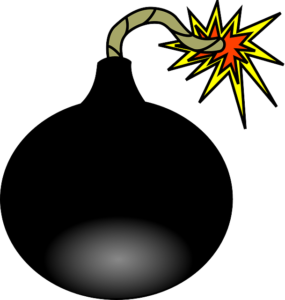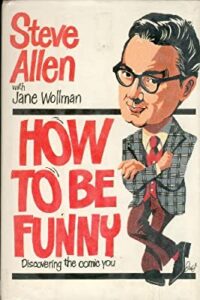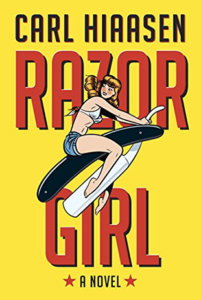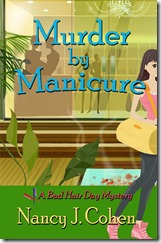“Dying is easy, comedy is hard.” That’s certainly true in thrillers and mysteries. Humor can enrich an otherwise serious novel, lightening a reader’s mood at just the right time and providing emotional contrast.
Today’s Words of Wisdom looks at how to add funny into your fiction, with posts by Jordan Dane, James Scott Bell, and Reavis Wortham. The full posts for each excerpt are well worth reading, and date-linked below.

FIVE WAYS TO ADD HUMOR
2.) Write Earnest Dialogue With a Sarcastic Internal Monologue from the POV Character
Cut loose on your inner smart ass with this type of scene. The dialogue lines would read as idle banter or may not appear to have color, until the reader sees what the character is thinking or gets a whiff of their cynicism. Whether you write in first person POV or deep third, you can make this happen and add attitude to your character. Remember, people don’t censor their opinion when they think no one hears them, in their head. So let the sarcasm fly, without filter.
Example: From My WIP – Legacy in Blood. My 24-year old bounty hunter wannabe, Trinity LeDoux, argues with Hayden Quinn about coming along on a dangerous trip:
“We? Oh, no,” he said.
“Yeah, but that’s the deal. I go too.”
“That’s crazy. I’m not a coaster ride at Six Flags. You can’t buy a ticket and climb onboard.”
If Quinn were a ride, I’d definitely buy a ticket, but now wasn’t the time to embarrass us both. I had to find another way to pique his interest before he voted me off his island.
Example: Hayden notices Trinity is carrying a weapon when he “visits” her condemned warehouse home
“You’re carrying a weapon,” he said as he let me pass. “I feel better already.”
Busted. Okay, yeah. I had a gun tucked under my Ren and Stimpy T-shirt, my one big investment in my new career. I couldn’t read Hayden’s reaction, but his deadpan sarcasm had begun to grow on me.
I’d once argued that bullets were more valuable than a gun. My shooting instructor went ape shit crazy over that one, especially when I said, ‘Without bullets, any gun is only a passable paperweight.’ It’d been a chicken and egg argument. You had to be there.
3.) Use Funny Sounding Unusual Words to Add Color & Humor
How about these zingers? Bamboozled, bazinga, bobolink, bumfuzzle, canoodle, carbuncle, caterwaul, cattywampus, doohickey, gobsmacked, gunky are but a few of the words listed in my link below, but imagine how you might use these words in a story and who might say them. These words alone could stir your imaginings on a character.
Example: The word ‘parsimonious’ means stingy. Here is how I used it in my latest WIP – Legacy in Blood:
I hadn’t eaten since early yesterday. If Hayden didn’t kick me off his property, I’d eat enough to last. I’d stuff it in my cheeks like a parsimonious squirrel if I had to.
(The internal voice of Trinity LeDoux. She’s presently homeless and beggars can’t afford to be persnickety.)
4.) Try Tongue-in-Cheek/Deadpan Delivery in the Banter Between Characters
In my opinion, less is more. Write the banter in short punches and don’t explain. If the reader finds it funny, that’s good, but don’t overwork it by trying too hard to be funny. Also be mindful of pace. Too much of a diversion can slow the plot. Get in, get out. Or in the case of Robert Crais’s example below, add several quick schticks of the same idea (ie. John Cassavetes) through the book to reinforce the humor in short spurts.
Example: In Monkey’s Raincoat, Robert Crais carries on a schtick with Elvis Cole, PI. A new client flatters him by saying he looked like a young John Cassavetes. After that, Cole asks others if they think so too. Each short punch is funnier and funnier. Here’s one encounter:
“Tell me the truth,” I said. “Do you think I look like John Cassavetes twenty years ago?”
“I didn’t know you twenty years ago.”
Everyone’s a comedian.
Example of Lillian’s POV from my novella – Lillian & Noah:
“It’s a sexual fantasy site,” I said. “Members share their most intimate erotic fantasies on their profile.”
“In my day, guys just wrote those on a bathroom wall.” Vinnie snorted.
“Shut up, Vinnie. Let her finish.” Candy shushed him with her red nails. “What happens next, doll? I think I saw something like this on Days of Our Lives.”
I clenched my jaw as heat rushed to my face. Not even a pig in a blanket helped.
Jordan Dane—June 12, 2014
So let’s talk about humor used on occasion in an otherwise serious novel. Why have it at all? Comic relief, as the name implies, is a spot within the suspense where the audience can catch its breath. It delivers a slight respite before resuming the tension. It’s sort of like the pause at the top of a roller-coaster. You take in a breath, look at the nice view and then…BOOM! Off you go again. It adds a pleasing, emotional crosscurrent to the fictive dream, which is what readers are paying for, after all.
I see three main ways to weave humor into a novel: situational, descriptive, and conversational.
Situational
You can insert a scene, or a long beat within a scene, that takes its comic effect from the situation the character finds himself in. For an example I turn to the great Alfred Hitchcock, who almost always has comic relief in his masterpieces of suspense.
Like the auction scene in North by Northwest. Roger Thornhill (Cary Grant) has been mistakenly tagged as a U.S. secret agent by a group of bad guys. At one point, Thornhill walks into a fancy art auction to confront the chief bad guy (James Mason). But now he’s stuck there with three deadly henchmen waiting in the wings to send him to the eternal dirt nap.
So Thornhill hatches a plan. Act like a nut and cause a commotion so the cops will come in and arrest him, saving him from the assassins. This is how it goes down:
How do you find situational humor? You look at a scene and the circumstances and push beyond what is expected. Most humor is based upon the unexpected. That’s what makes for the punch line in a joke, for example. So make a list of possible unexpected actions your character might take or encounter, and surely one of them will be the seed of comic relief.
Descriptive
When you are writing in First Person POV, the voice of the narrator can drop in a bit of humor when describing a setting or another character. The master of colorful description was, of course, Raymond Chandler, through the voice of his detective, Philip Marlowe:
It must have been Friday because the fish smell from the Mansion House coffee-shop next door was strong enough to build a garage on. (“Bay City Blues)
From thirty feet away she looked like a lot of class. From ten feet away she looked like something made up to be seen from thirty feet away. (The High Window)
It was a blonde. A blonde to make a bishop kick a hole in a stained-glass window. (Farewell, My Lovely)
The girl gave him a look which ought to have stuck at least four inches out of his back. (The Long Goodbye)
For descriptive humor, listen to your character. Use a voice journal to let the character riff for awhile. You’ll unearth a nugget or two of descriptive gold.
Conversational
Dialogue presents many possibilities for humor. First, you can create characters who have the potential for funny talk. Second, you can take create conversational situations where such talk is possible. I had two great aunts who lived together in their later years. They had a way of subtly sniping at each other over minor matters, which was always a source of amusement to me. So I put them in my thriller, Long Lost, as two volunteers at a small hospital:
Just inside the front doors, two elderly women sat at a reception desk. They were dressed in blue smocks with yellow tags identifying them as volunteers. One of them had slate-colored hair done up in curls. The other had dyed hers a shade of red that did not exist in nature.
They looked surprised and delighted when Steve came in, as if he were the Pony Express riding into the fort.
They fought for the first word. Curls said, “May I help—” at the same time Red said, “Who are you here to—”
They stopped and looked at each other, half-annoyed, half-amused, then back at Steve.
And spoke over each other again.
“Let me help you out,” Steve said. “I’m looking for a doctor, a certain—”
“Are you hurt?” Curls said.
“Our emergency entrance is around to the side,” Red said.
“No, I—”
“Oh, but we just had a shooting,” Curls said.
“A stinking old man,” Red added.
“Not stinking,” Curls said. “Stinko. He was drunk.”
“When you’re drunk you can stink, too,” Red said.
“That’s hardly the point,” Curls said.
And it goes on like that.
I think you can develop an ear for this kind of humor by soaking in the masters of verbal comedy. Start with Marx Brothers, especially their five best movies: The Coconuts, Animal Crackers, Monkey Business, Horse Feathers, Duck Soup.
James Scott Bell—December 13, 2020
I sat in on a humor writing class once, and came out weeping. The presenter broke down humor with sentences like, “Writing comedically usually requires establishing a setup pattern and then misdirecting the reader by throwing in a punch line. The simplest way is to create a pair of ideas and then add an incongruent statement. I like to list three, because 30 is too many.”
Good lord.
How about misdirection, which can be funny by taking readers someplace they expect to go and suddenly shifting direction.
“I looked down at my five-year-old son who broke the window and lied about it. I was shocked to think he wouldn’t tell the truth, and had to get him to understand what he’d done wrong, so I knelt on one knee, took his small shoulders in my big hands and looked him in the eye. Son, I have something to tell you.”
“What?”
“Quit picking your nose.”
Most of the things we laugh at in real life are true stories that someone exaggerates for effect. I once wrote a column about running from a bear while wearing a backpack…
“That thing was right on my heels, and I ran like rats across the tundra. My backpack came open and I left a string of equipment behind, my tent, half the food I’d packed, tent stakes, the stove, a laptop computer, two cameras, a chair, the kitchen sink and a VCR along with all my John Wayne videos. Now light as a feather, I left the bear far behind, sniffing the laptop full of newspaper columns and probably wondering what stunk so bad.”
Some other things I’ve learned:
Don’t try to write jokes. Look for something that happened in real life and make a few changes. Here in Texas, every truck has a trailer hitch. We all know they’re right there, but when the guys get together, someone inadvertently barks his shin on the damn thing. While we curse and rub that shin, the rest laugh like loons. What is it that makes us guys giggle like little girls? We’ve all done it. Exaggerated familiarity is funny
Don’t tell your reader something is funny: “Hurts, don’t it,” he joked. Like the old saying goes, if you have to explain it, it ain’t funny.
Avoid sarcasm, except to identify a character.
Surprise your reader.
I’ve judged humor writing contests, and cousin, exclamation points don’t make a story funny!
Use humor sparingly, unless you’re shoving it in someone’s face, like this slightly insane column I wrote some years ago about an Outdoor Detective that somehow caught on with readers. I only produce one of these a year. They’re a lot like fruit cakes, you don’t want too many, but an occasional bite is good.
Reavis Wortham—November 27, 2021
***
- Do you enjoy some funny to go with the serious in your fiction?
- Do you have a favorite trick or tip to share about inserting humor into a novel?
- Is there an author you feel who does this especially well?





 Readers and movie viewers typically don’t take comic villains seriously because they’re often lousy criminals. They’re buffoons whose sloppy schemes go awry. Their supposedly clever strategies explode in their faces. Their mistakes get them knocked on their butts.
Readers and movie viewers typically don’t take comic villains seriously because they’re often lousy criminals. They’re buffoons whose sloppy schemes go awry. Their supposedly clever strategies explode in their faces. Their mistakes get them knocked on their butts. 









![200px-George_Spanky_McFarland[1] 200px-George_Spanky_McFarland[1]](https://killzoneblog.com/wp-content/uploads/2011/05/200px-George_Spanky_McFarland-5B1-5D_thumb.jpg)